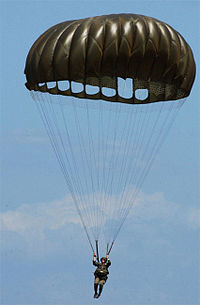Round parachutes, which are purely drag devices (that is, unlike the ram-air types, they provide no lift ), are used in military, emergency and cargo applications. These have large dome-shaped canopies made from a single layer of triangular cloth gores. Some skydivers call them "jellyfish 'chutes" because they look like dome-shaped jellyfish. Rounds are rarely used by skydivers these days.
The first round parachutes were simple, flat circulars, but suffered from instability, so most military round parachutes are some sort of conical (i.e. cone-shaped) or parabolic (picture a flat circular canopy with an extended skirt) US Army T-10 parachute used for static-line jumps.
Round parachutes are designed to be steerable or non-steerable. Steerable versions are not as maneuverable as ram-air parachutes. An example of a steerable round is provided in the picture of the paratrooper's canopy; it is not ripped or torn but has a "T-U cut". This kind of cut allows air to escape from the back of the canopy, providing the parachute with limited forward speed. This gives the jumpers the ability to steer the parachute and to face into the wind to slow down the horizontal speed for the landing. The variables impact the way and the speed that the parachute falls, because it depends on the speed or the amount of force in the wind that might change how a parachute falls.


















































No comments:
Post a Comment